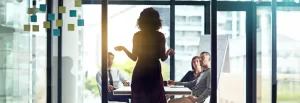It takes More than Change to Transform your Workplace Culture
"Do you intend to create a change or do you want to transform your culture? Without a firm understanding of each, you may find things becoming more difficult than they should be."
Share This Post
It Takes More Than Change to Transform Your Workplace Culture
Transformation is certainly not easy, and things can get especially complicated–quickly and needlessly–when it comes to overhauling your organizational culture. The greatest determiner of success is being clear on what you’re after. This is never truer than with diversity, equity and inclusion initiatives.
Tweak your vocabulary for clear insight
Do you intend to create a change or do you want to transform your culture? Without a firm understanding of each, you may find things becoming more difficult than they should be. The term ‘change’ is often used as a synonym for ‘transformation,’ but the two are actually very different. The main difference between change and transformation is that with change, your future is a reconditioned or improved version of the past. Choosing change implies that, if the
initiative is properly orchestrated, your employees will generally know what to expect and can predict what the end result will be.
Transformation, on the other hand, brings about the new by realizing that our actions today create the future we envision for our tomorrow. As Frederic Laloux says, “In transformation, we stop trying to force the future into existence and instead we dance with what wants to emerge.” In transformation, we attune to the organization’s evolving purpose while freeing ourselves from the limitations of the past. The result is not an endpoint, but a dynamic unfolding.
Progress is all in a Letter
Another way to think about it is that, in terms of development—individual or organizational,—change refers to a state while transformation refers to a stage. A state is an action, a thought or feeling, a one-off experience that happens within a given stage of development. In change, any movement, including growth, is horizontal. The status quo is unperturbed. In the big picture, things remain the same. Transformation, by contrast, brings about a new stage altogether, a leap up the developmental ladder, or, if you prefer, progression of the spiral, resulting in more adaptive ways of acting, thinking and feeling. In transformation, direction is vertical, upward.
Due to the pandemic and racial unrest, organizational leaders are now recognizing and uncovering fissures in their foundations. With a keener eye, they are detecting long-standing yet previously overlooked social justice and equity issues. In many organizations, DEI efforts are now igniting new, deeper, timely, and relevant conversations that are precipitating organizational transformation. Leading an organization through DEI transformation requires leaders to
deconstruct the crumbling foundations of long-standing inequitable systems and rebuild new, stronger, equity-focused footings. Incredible results are rapidly emerging. Outstanding, unprecedented improvements are increasingly apparent, including remarkable levels of workforce engagement.
“The greatest danger in times of turbulence is not the
turbulence; it is to act with yesterday’s logic.”
– Peter Drucker
Safety is transformative
Among the key questions for leaders to be addressing now is, what can we do to invite an entirely new future while lacking clarity about the challenges along the way? One clear answer is to co-create psychological safety needed for effective workplace culture transformation. The intention is to step up beyond inclusion to reap the many benefits that full-on engagement and stakeholder participation brings. These steps, inspired by Edgar H. Schein’s psychological safety model, will support your workplace culture transformation:
Co-create a compelling positive vision with your employees and stakeholders. Building a new vision of the future by involving people increases buy-in and provides a clear framework for evolving a new mindset and the behavioral changes required to achieve it. This entails engaging with and encompassing the experiences of all stakeholders and deploying asset-based methodologies instead of root deficit analysis methodologies.
Build individual and collective capacity through vertical development. Vertical development means each person is gaining fresh perspectives and mindsets needed to birth the new future as well as the capacity to think in more complex and systemic ways. Educate and train employees, Board members and other stakeholders so they themselves can be individually transformed and evolve into the new mindset required to achieve the new vision.
Provide coaching opportunities and feedback. Provide time, resources and coaching necessary for leaders and staff to learn, practice and get valid feedback about how they are doing. Practice environments provide an opportunity for the learner to make mistakes without potential negative consequences, which will increase their confidence and skill.
Posit yourself as a positive role model. DEI changes are intrinsic and subtle and require a new mindset and way of thinking that may be unfamiliar and discomforting for most. They must witness what it looks like and see the new behavior and attitudes in their leaders and others who they can trust and identify with.
Cultivate a learning organization. According to author Peter Senge, a learning organization is “a group of people working together collectively to enhance their capacities to create results they really care about.” Even the most well-intended people are not experts in matters of diversity or equity. In matters of diversity and equity, all of us truly are learners. By promoting a learning organization, inspired by curiosity, you foster conditions for rapidly co-creating transformation.
Provide emotional support. No matter what its nature, even when we are welcoming it, change is often challenging. DEI initiatives are one of the most challenging change areas of all. Reach out, be proactive, ask employees what they need to feel supported in their growth. Provide safe spaces where learners can talk about the blockings and struggles of learning with others that are experiencing similar challenges. As Martin Luther King, Jr. said, “We might have come in on different ships. But we’re all in the same boat now.”
Contact us today to learn more about how we can help you transform your workplace culture
beyond inclusion.
Read more Posts

5 Signs Your Leadership Isn’t Evolutionary (and Why It Matters)
“Studies reveal that more than 40% of our behaviors are driven by fixed beliefs, habits, biases, and blind spots.”

Leading Through Complexity: How Purpose-Driven Evolutionary Leaders Can Navigate the DEI Backlash
“Evolutionary leaders aim to build trust, encourage collaboration, and guide their teams through change with purpose and empathy.”